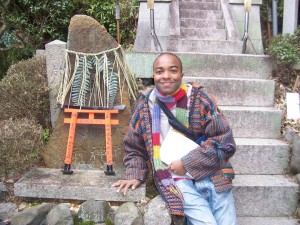JQ Magazine: JQ&A with JUSTE Program Participant Kazumoto Takechi
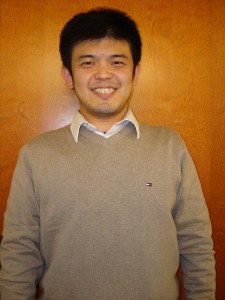
"I would like the duration of stay in this project extended as long as possible. Hopefully, this project will revolutionize Japanese English education just as the JET Program has changed the landscape of English language education in Japan."
By Sierra Soleil (Fukushima-ken, 2000-02) for JQ magazine. Sierra works at an ESL school in Manhattan. He enjoys teaching, writing, and riding his bike.
It’s been called the “Reverse JET Program,” which is a lot catchier than the Japan-U.S. Training and Exchange Program for English Language Teachers (JUSTE Program). A few of the East Coast JUSTE teachers made a special public appearance at the JETAANY Welcome Back Reception in November, and since then there has been some talk about exactly what this program is, and what these teachers are up to.
Recently, Kazumoto “Kaz” Takechi, a JUSTE participant at Rutgers University in New Jersey, took some time out of his busy schedule to answer a few questions about his experience as a Reverse JET. Spoiler alert: the program is very new, and its future is not assured, especially with the budget restrictions caused by the problems in Fukushima. However, if Kaz’s attitude is at all typical of the other participants, JUSTE could be every bit as much of a game-changer as JET was.
Kaz got his MA in English education from Naruto University of Teacher Education in 2002, and works at Ishii Junior High School in Tokushima, Shikoku. He was nominated by the program as one of 96 Japanese teachers of English to spend six months in the U.S. through January of this year, and is the only JUSTE teacher from Tokushima. Before he got to my questions, Kaz started with a shout-out to his former ALTs:
“All of my ALTs have been great partners in the classroom. I am a very lucky teacher because I have met very wonderful ALTs during my nine years as an English teacher. I am really glad to participate in this article for ALTs.”
Where did the idea come from to send teachers to the U.S. in order to improve English education in Japan?
According to the Foreign Ministry Advance Institute Workshop held at Tokyo in May 2010, both Japan and the United States agree that the two countries need to foster mutual understanding at the citizen level in order to sustain and strengthen the Japan-U.S. alliance. Based on this agreement, a summit conference between Japan and the U.S. was held in Yokohama on November 13, 2010. Details on how to strength our relationships were finalized during this conference. The JUSTE project is a direct outcome of this conference. The Ministry of Education further defined that the JUSTE project had two objectives. One is to foster and develop the English communicative skills of Japanese English teachers. The other is to develop Japanese English teacher pedagogical skills through TESOL classes offered at U.S. institutions.
Has this idea been around for a long time, or was it a recent initiative?
The Ambassador Plenipotentiary has wished that this project take motion for some time. He has consistently envisioned the necessity to give Japanese English teachers the opportunity to seek professional development, in English speaking countries such as the U.S., after they become certified English teachers in Japan. He has consistently suggested this to the government, and thanks to his wonderful efforts this project has finally materialized.
How would you assess the progress so far?
At this juncture, I am focusing on developing the skill sets that will contribute to the professional development of Japanese English teachers and ALTs when I return to Japan. I will be presenting to the English language teacher community as well as conducting demonstration lessons to assist in their professional development. Moreover, I will also write some articles about my experience in this project. Hopefully, I will inspire other English teachers and muster support for this project among supervisors and English language teachers. This is a challenge I am embarking on, but I have conviction that my actions will positively influence other English teachers and the future of Japanese English education.
JQ Magazine Needs New Writers for Winter 2012!
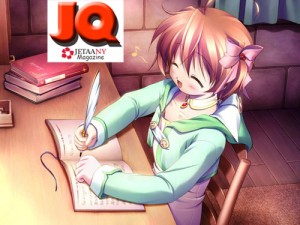 As we welcome a new year, JETAA New York’s JQ magazine continues to provide content with an ever-expanding array of articles, interviews and features (see our recent stories here). We’re now looking for new writers (including new returnees and JET vets) from all JETAA chapters worldwide to write and share more material that we can post online to the widest JET readership on the web through our hosts at the global JET alumni resource site JETwit.com.
As we welcome a new year, JETAA New York’s JQ magazine continues to provide content with an ever-expanding array of articles, interviews and features (see our recent stories here). We’re now looking for new writers (including new returnees and JET vets) from all JETAA chapters worldwide to write and share more material that we can post online to the widest JET readership on the web through our hosts at the global JET alumni resource site JETwit.com.
Below are story ideas grouped by JET participants and alumni (JET World) and those more on Japanese culture (Japan World). If you’re a JET or JETWit contributor from anywhere in the world, we welcome your interest or additional story ideas! Click “Read More” below to see our story ideas, and contact JQ’s editor Justin Tedaldi (magazine [at] jetaany [dot] org) to sign up.
JQ Magazine: In Kyoto, a New Year’s Day Disaster
By Rashaad Jorden (Yamagata-ken, 2008-2010) for JQ magazine. Rashaad worked at four elementary schools and three junior high schools on JET, and taught a weekly conversion class in Haguro (his village) to adults. He completed the Tokyo Marathon in 2010, and was also a member of a taiko group in Haguro.
New Year’s Day. A day some welcome in a crazed stupor while others might celebrate it in serenity. Or maybe confusion.
I would be spending my New Year’s Day on vacation in the Kansai region. Upon getting off the bus in Osaka, I had no idea what locales I’d explore. But my plans were nothing to be stressed about as I’d simply follow the recommendations of my Lonely Planet.
And others. Shortly after checking into my hostel in Osaka, I met an American college student on a homestay in Tokyo. She had come to town for the same reason I had. So quite naturally, we started to talk about places worth visiting in the Kansai region. Fortunately for me, she was familiar with several tourist spots in the area.
I definitely knew about Kyoto’s infinite number of shrines, but I wasn’t sure which ones to visit. However, my compatriot recommended Kiyomizu-dera, Kinkaku-ji, and Fushimi Inari-taisha.
So I was off to Kyoto the next day. I crossed the first two locales off my list, but I didn’t have time to fit in Fushimi Inari-taisha. No worries—I had two more days in the region. My biggest concern was finding something to do other than going to bed at 10 p.m. on New Year’s Eve. Fortunately, four other Yamagata Prefecture ALTs who were taking a road trip to Hiroshima stopped in Osaka that night, so I had some friendly faces to ring in the new year with.
JQ Magazine: JET Turned Laborer – Giving Back as a Volunteer in Post-Disaster Japan

Rachel at work "gutting," or removing drywall panels and screws, in the stairwell of Wakadaisho, a sushi restaurant undergoing renovation in Ofunato, Iwate.
By Rachel Vigil-Garcia (Fukushima-ken, 2001-02) for JQ magazine. Rachel works at the American Center for Learning in Chula Vista, CA. Contact her at ray3vigil13 [at] yahoo [dot] com.
Eight months have passed since a huge earthquake and tsunami crippled Northeastern Japan with mind-numbing destruction. In March, news video beamed entire towns going under, with cars and homes lifted in the deluge. But today, why does it seem like so many have begun to forget about this disaster? I know the JET and JET alumni community are an exception to this. Still, I hope that by sharing my recent experience I can encourage sustained support to that wonderful island nation and its ever-gracious inhabitants. It’s much too early to be letting Japan’s victims and survivors, and the hard work ahead, fade into the background.
When news of the events of March 11 reached my living room in San Diego, it took hours for the magnitude and scope of the tragedy to sink in. I sat, scrolling through unbelievable Internet images with an eerie sense of irony as my mind brought me back 10 years. Suddenly, it wasn’t March 11, but September 11. I wasn’t in San Diego. I was on a tatami mat in my apartment in Koriyama, as a JET in Fukushima. The 9/11 terrorist attacks gripped the world in complete surprise. I was glued to NHK and local Fukushima TV, wondering how something so awful could be going on back home while I was thousands of miles away.
The realization of this strange twist of events compelled me to take action this summer. I was an ALT in Japan during the 9/11 terrorist attacks. Ten years later I felt the same helplessness and fright for Japan, a nation not mine by birthright, but one that had become a second home. With growing conviction and a sense of obligation, I vowed to find an organization accepting U.S. civilian volunteers. I was determined to help Japan recover and rebuild.
December edition of “AJET Connect” now online
***************
A really terrific December edition of AJET Connect online magazine is now available for viewing at:
https://s3.amazonaws.com/AJET/AJET+Connect+DEC+2011.pdf
JQ Magazine: Book Review – ‘Life After the B.O.E. the Book’
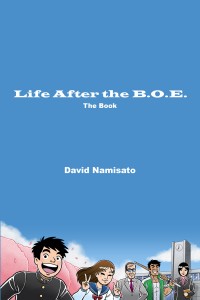
"This whimsical compilation of cartoons that appeared previously in JETAA publications worldwide is likely to hit the funny bone of both former and current program participants alike."
By Sharona Moskowitz (Fukuoka-ken, 2000-01) for JQ magazine. Sharona works at a literary agency in New York City. She is interested in fresh, new voices in fiction and creative nonfiction.
Flexibility and a sense of humor have long been predictors of a successful JET participant. And with good reason. After all, let’s face it: life in Japan for a gaijin can range from the frustrating to the absurd to the downright hilarious, often within the same day.
The malleable young JET is expected to smile and wear a variety of hats placed upon his or her head in the name of “international exchange.” For most JETs, it’s what happens in between the lines of the job description that makes the experience so meaningful.
Who better to capture the flexible thinking and sheer comedy of the JET experience than a former participant himself? JET alum and professional illustrator David Namisato (Aomori-ken CIR, 2002-04) showcases some of the more memorable aspects in his new book Life After the B.O.E. This whimsical compilation of cartoons that appeared previously in JETAA publications worldwide is likely to hit the funny bone of both former and current program participants alike.
Each cartoon presents a different familiar scenario. There is the moment of sudden awareness when it becomes all too clear to the ALT that he or she is more of an exotic show-and-tell object than a real teacher, a realization that can be disappointing, underwhelming, or just a huge relief, depending on who you ask. Read More
JET alum paper published: “A New Framework for US-Japan Development Cooperation”
Jim Gannon (Ehime-ken, 1992-94), Executive Director of the Japan Center for International Exchange (JCIE/USA), has a new paper published as part of JCIE’s “Enhanced Agenda for US-Japan Partnership” paper series titled:
- “A New Framework for US-Japan Development Cooperation“ (PDF) http://www.jcie.org/researchpdfs/USJapanPapers/Gannon.pdf
Click here for other JCIE papers in the series.
Embassy of Japan in the UK Webmagazine (December 2011)
Embassy of Japan in the UK Webmagazine round-up. Posted by JET alum and current editor of the webmagazine, Dipika Soni (Ishikawa-ken, 2003-06). To subscribe to the Embassy of Japan’s monthly webmagazine, email webmagazine@ld.mofa.go.jp with the subject ‘subscribe’.
——————————————————————————————————————————–

Feature article:
Spotlight on… Captain Minami
Other articles this month:
POSTCARDS FROM JAPAN – A Message from Tohoku Artists
Films at the Embassy of Japan: Always – Sunset on Third Street 2
UK-Japan Music Society 20th Anniversary Christmas Concert
Tohoku students play at Wembley!
Japanese Food: Interview with award-winning chef Asuka Kobayashi
Japanese representatives visit London ahead of the 2012 London Olympics
New Centre for Japanese Studies at the University of East Anglia
Tokyo: “What is the city but the people” by Simon Wright
Supporting Tohoku through volunteering and tourism
JET News Roundup 12.12.11
Posted by Jessica Cork (Hiroshima, 1997-2000); JET Program Coordinator, Consulate General of Japan in Atlanta
Article from the Japan Times that mentions the JET Programme:
Japan faces the serious issue of a dwindling number of children and a shrinking workforce. So far in this situation, not much has been done to make use of foreign students studying in Japan, who may become essential resources to relieve the labor shortage. Leading figures from academia and the business world were recently invited to discuss ways in which to attract more foreign students to study and work in Japan.
The speakers were Kenji Honma, president of the Hokkaido University of Education, Yohei Otani, a general manager at NEC Soft, Nam-Kung Sung Il, an executive director at the Tokyo YMCA, Larry Greenberg, CEO of Urban Connections, and Keiko Iwata, president of Heart Connections.
The Rice Cooker Chronicles — “Kaijo!” by Justin Maki
The Rice Cooker Chronicles is a series of essays by JETs and JET alumni on the theme of cooking/eating and being alone in Japan. The brain-child of JETwit founder Steven Horowitz (Aichi-ken, Kariya-shi, 1992-94) (and inspired by the book Alone in the Kitchen with an Eggplant), this series is curated by L.M. Zoller (CIR Ishikawa-ken, Anamizu, 2009-11), the editor of The Ishikawa JET Kitchen: Cooking in Japan Without a Fight. A writer and web administrator for The Art of Japan: Kanazawa and Discover Kanazawa, ze also writes I’ll Make It Myself!, a blog about food culture in Japan.
New submissions always welcome. Just e-mail it to jetwit [at] jetwit.com.
******
Kaijō!
by Justin Maki (ALT Osaka-fu, 2002-06), a writer and editor currently working at the Sports desk of Kyodo News America in New York City. Justin’s short fiction, poetry, and essays have appeared in a handful of small journals. Contact him at makij408@gmail.com.
“When you go to the kitchen to prepare dinner, be born in the kitchen. When you finish there, die. Then be born at the dining table as you eat your dinner and, when you finish eating, die there. Be born in the garden, and sweep with your broom. When you get into bed at night, die there. And when daylight comes, and you awaken in your bed, be born anew.”
Justin’s Japan: Interview with Kaoru and Die of Dir En Grey on the Band’s ‘Dum Spiro Spero’ Tour
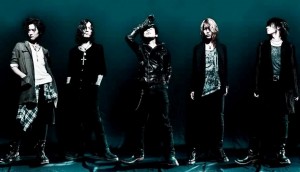
Die of Dir En Grey: "Things that we took for granted before now feel more important than ever. We now venture forth into every single day, every new encounter, every concert we play, with everything we have." (Courtesy of MSO PR)
By JQ magazine editor Justin Tedaldi (CIR Kobe-shi, 2001-02) for Examiner.com. Visit his page here for related stories.
Dir En Grey’s latest album is called Dum Spiro Spero, a Latin phrase meaning “While I breathe, I hope.” Hope is hard to associate with this murky Osaka quintet, whose previous numbers include “Child Prey,” “Repetition of Hatred” and “Agitated Screams of Maggots.”
But if killing is their business, then business is booming. Fresh from dates in South America and Mexico, the group is touring the U.S. and Canada through Dec. 23, with a high profile gig at New York’s Irving Plaza on Monday (Dec. 12). In this exclusive interview, I caught up with guitarists Kaoru and Die to discuss their sizable worldwide fanbase, scorning their government after the Great East Japan Earthquake, and their thoughts on the current protest movements in America.
he cover art of Dum Spiro Spero is said to represent Tara, the Mother of Liberation in Tibetan Buddhism. What was the inspiration for this?
Kaoru: The original idea had nothing to do with Tibetan Buddhism, to be honest. We simply wanted to capture something real and raw and decided to go with a photograph instead of the usual graphics and came up with the current cover.
Dir En Grey has gained a big audience around the world without having to write songs that rely on “pop” sounds or even English. What do you think is the reason for that?
Kaoru: I think the fact that we are not mainstream is why we appeal to the core fans.
Dir En Grey has been called a band in its own genre. How would you describe the style of your music at this point?
Kaoru: What we try to depict through our music comes from all the negative and unsightly parts of a human being.
For the complete interview, click here.
JQ Magazine: JETAANY Artist Showcase Unites Fukushima, New York
By Carolyn Brooks (Ishikawa-ken, 2006-11) for JQ magazine. Carolyn is co-author of the blog MadSilence–a cross-cultural blog written with her father–and a current culture/education related job-seeker in the New York area available for full-time or consulting work.
“At this festive season of the year, Mr. Scrooge,” said the gentleman, taking up a pen, “it is more than usually desirable that we should make some slight provision for [those in need], who suffer greatly at the present time….We choose this time, because it is a time, of all others, when Want is keenly felt, and Abundance rejoices.”
—Charles Dickens, A Christmas Carol, brackets by author.
It was in the generous spirit of the holiday season that over 150 guests, including former New York City mayor David Dinkins and a visiting delegation of dignitaries from Fukushima, joined together Dec. 1 for a reception and silent auction to show support for Tohoku as it continues to struggle after the Great Eastern Earthquake last March. The event, organized in partnership by the Consulate General of Japan in New York and the New York chapter of the JET Alumni Association (JETAANY), was held at Ambassador Shigeyuki Hiroki’s residence on the east side of Central Park.
JETAANY utilized its extensive network to get 14 artists involved, displaying and auctioning off more than 30 pieces of art including sculpture, prints, paintings and antique ceramics. The artists and donators really showed the scope of people who have connections with Japan, ranging from JET Program alumni and parents to Japanese expats and students. All in all, the auction raised $700, and with other donations received that night totaled more than $1300. Read More
Justin’s Japan: Studio Ghibli Festival Mounts Monthlong, 15-Film Retrospective
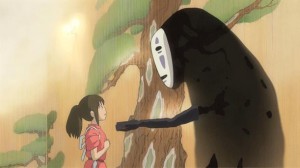
Hayao Miyazaki's Academy Award-winning 'Spirited Away' screens as part of the Studio Ghibli Festival, running Dec. 16 to Jan. 12 at New York's IFC Center. (GKIDS)
By JQ magazine editor Justin Tedaldi (CIR Kobe-shi, 2001-02) for Examiner.com. Visit his page here for related stories.
The holidays have come early for Studio Ghibli fans.
From Dec. 16 to Jan. 12, GKIDS will host a massive four-week film retrospective from Japan’s internationally acclaimed animation studio at the IFC Center in Greenwich Village.
Founded in 1985 and led by directors Hayao Miyazaki and Isao Takahata, Ghibli (based on the Arabic name for the sirocco, or Mediterranean wind) is home of some of the greatest anime films of all time, including the Academy Award-winning Spirited Away (also the highest grossing film in Japanese history), My Neighbor Totoro, Castle in the Sky, Princess Mononoke, Kiki’s Delivery Service and more. The studio even has its own museum in Tokyo, which recently celebrated its tenth anniversary and showcased two of its short films at Carnegie Hall in March in a rare a one-time-only exception to its screening policy.
For this first-ever Studio Ghibli Festival, all films will be shown on sparkling new 35mm prints, including the North American premieres of Takahata’s Only Yesterday and Tomomi Mochizuki’s The Ocean Waves.
The retrospective should also whet fans’ appetites for the next Ghibli film to be released in North America, The Secret World of Arrietty. Co-written by Miyazaki and based on Mary Norton’s award-winning novel series The Borrowers, Arrietty arrives in theaters Feb. 17.
For the complete story, click here.
JQ Magazine: Georgia JETs’ Ganbare Tohoku Shows Social Media Savvy
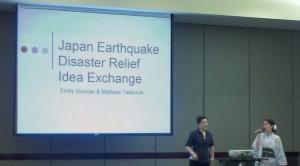
JET alumni Emily Duncan and Mellissa Takeuchi presenting at Georgia’s annual JapanFest, Sept. 17, 2011.
By Emily Duncan (Hyogo-ken, 2005-08) for JQ magazine. Emily is a graduate of the Lamar Dodd School of Art at the University of Georgia.
When I was a JET, I worked at Himeji Nishi Senior High School and enjoyed my time there immensely. I would love to return to Japan, if only for a visit.
Since a transcontinental, transpacific trip is a bit too much of a stretch for my wallet right now, I, like many of you, have an application essay ready for the day that JNTO begins their campaign for the 10,000 free flights to Japan (should the Diet rethink approving this plan for next spring, of course).
On March 11, 2011, I was asleep when the massive earthquake struck northeastern Japan (after all, it was about 1 a.m. in Atlanta). When I awoke, there was an e-mail news alert on my phone. I spent a chunk of time that morning trying to call friends in the Himeji area, but everyone was fine as they live about an hour west of Osaka. Plenty of room between them and disaster.
The rest of the day—the rest of the weekend, really—I spent occasionally checking in on the progression of events in Japan through news sources online. I reached out to the JETAASE and the Japan-America Society of Georgia with fundraising ideas. But neither group had decided upon a plan of action.
Impatient, I called my friend, Mellissa Takeuchi, fellow Hyogo-ken JET alum, to brainstorm. We thought of ideas for fundraising, but the one immediate and tangible takeaway from the conversation was that we should establish a Facebook page to catalogue the ongoing narrative of the Tohoku Earthquake, the tsunami disaster and the ensuing recovery effort.
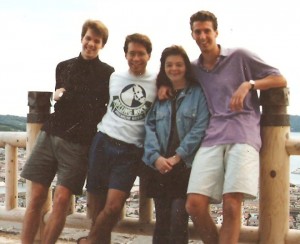
Alan (far right) with 1992-94 Kamaishi JETs (L to R: Kevin McCallum, Yves Lacasse, Kathryn Morris,) on top of Mt. Shiroyama, Ohtsuchi, 1992.
By Alan Mockridge (UK JET, Iwate-ken, 1992-94) for JQ magazine. Alan was one of 14 JET alums selected for the Tohoku Invitational Program sponsored by the Ministry of Foreign Affairs and the Japan Tourism Agency. He is a co-owner of Intralink, which provides business development services for U.S./European companies wishing to do business in/with Japan, China, Korea and Taiwan. Post-JET, he lived in Japan for 13 years before moving to Santa Clara, California in 2008. Intralink employs half a dozen fluent Japanese speaking JET alums in its Tokyo office.
Until a friend at university who I was studying German with suggested we apply for the JET Program as a year out after graduation, I could not even have located Japan on the map. On my application form I answered the question, “Do you have a placement request?” as “Somewhere rural.”
I got my wish. I was placed in Ohtsuchi, a fishing town of less than 15,000 people on Japan’s northeast Pacific coast, where I taught English as an assistant language teacher in three senior high schools: Ohtsuchi, Kamaishi Kita and Yamada. The experience changed my life but although I have remained intimately connected with Japan over the past 17 years, my direct links to these schools have naturally faded over time. That changed in the early hours of March 12, 2011 (PST).
When I saw the first earthquake and tsunami news reports coming out of Iwate my memories came racing back. I realized that I had lost contact with most of the teachers and townsfolk who had befriended me. There had been no e-mail or cell phones when I left in 1994, and gradually my New Year’s cards started to go undelivered from around 2008 as teachers were moved to different posts further and further from the coast. I decided I had to find them all again, just to tell them that I had not forgotten their kindness. Read More

